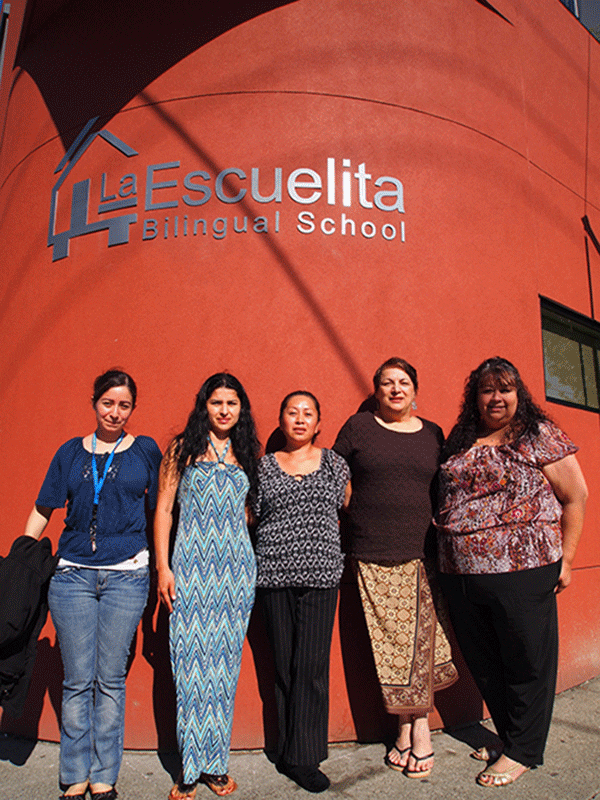The immigrant rights movement has achieved meaningful reform in our nation’s immigration policy concerning the treatment of undocumented youth and mixed legal status families. However, truly comprehensive immigration reform to normalize the status of millions of immigrants remains elusive and is unlikely to be achieved before the next presidential election. This is the moment to place greater focus on comprehensive immigrant integration into the social and economic fabric of our nation.
Immigrant integration has traditionally been understood as teaching English and supporting immigrants through the process of achieving legal status, both of which are necessary and important services. Comprehensive immigrant integration, however, must include services that directly support immigrants to become robust economic contributors and foster economic mobility for immigrants and their children.
Achieving legal immigration status is a tremendous asset that opens up the economic potential of immigrants. We must recognize, however, that even many immigrants who may be eligible for DACA/DAPA (the recently passed deferred action programs aimed at keeping families together) and who may benefit under future comprehensive reform, do not have the knowledge or the tools to fully participate in the financial and real estate marketplace in the United States.
For example, the FDIC consistently reports that over 50 percent of non-citizen immigrants are unbanked or underbanked. A lack of connection to regulated financial institutions, no documented credit history, and little understanding of consumer protections are among the factors that make immigrants tempting targets for unscrupulous and predatory actors who seek to strip them of their financial assets. The Brookings Institution estimates that the average unbanked individual spends $40,000 over their lifetime in fees to simply cash their paychecks. The Center for Responsible Lending reports that 12 million people in the United States are trapped every year in a cycle of 400 percent interest payday loans, and other research has demonstrated that areas with a higher density of payday lenders have higher concentrations of recent immigrants.
Immigrants also drive our small business sector and bring vitality to urban neighborhoods and rural communities alike. Research from a myriad of sources, including the Census Bureau, the Small Business Administration, and the Kauffman Foundation, finds the rate of business start-up among immigrants is higher than among any other major population segment, and yet many immigrants, especially Latino entrepreneurs, experience difficulty in accessing capital for business growth. Indeed, over 25 percent of Latino immigrant-owned businesses have zero startup capital available to them when they launch their business, higher than any other racial/ethnic subsector. Even more troubling is the fact that even when Latinos have access to capital it comes at an inequitably high cost. A recent article in Forbes, co-authored by staff from the Kauffman Foundation, described how Latino business owners pay higher borrowing costs, are offered smaller loans, and have their loan applications rejected more often than non-minority applicants. The study finds that even when Latino-owned businesses have identical business characteristics and credit reports compared to their non-minority-owned counterparts, they still gain less access to credit.
The community economic development industry (CDCs, CDFIs, and other community-based economic development entities) has focused on building family financial capability, investing in small businesses, and promoting equitable neighborhood development. The immigrant rights movement has focused on mass mobilization, policy advocacy, and addressing barriers to achieving legal status and family reunification. It is time to more directly connect these important infrastructures to support immigrant economic integration. It is not enough for us to work in poorly connected silos.
Integrating Integration Services
We know what works. Supporting immigrant economic integration requires a suite of integrated services, beginning with English language learning and legal support, and including financial coaching, tax assistance, workforce development, and, for many, small business development services. In most places, providing this range of services requires multiple organizations to collaborate and integrate their services.
Plaza Adelante in San Francisco’s Mission District provides an extraordinary example of service integration that promotes comprehensive immigrant integration. The Mission Economic Development Agency established this facility with the intent of housing multiple service providers, and partnered with their colleagues to develop systems for referring immigrant families and entrepreneurs to a range of culturally and linguistically relevant opportunities, all in the same building.
The Hispanic Interest Coalition of Alabama (HICA) faced a different challenge. After more than a decade of work as an advocate for immigrants and a social service provider, HICA sought to expand its services to invest more directly in the economic potential of the people they serve. Unlike the Mission District, Birmingham did not have a wealth of existing infrastructure to provide culturally and linguistically relevant asset-building services for immigrants. Further, the political and social environment for immigrants in Alabama was far less welcoming and made more challenging by draconian anti-immigrant legislation.
Undaunted, HICA set about developing a suite of asset-building services to integrate with its established advocacy and supportive services. HICA reached out to peer agencies from around the country through the national NALCAB Network for tools and systems it could replicate, and to access training to develop its own programmatic capacity. Today, HICA provides financial counseling, free tax preparation, and small business development services to hundreds of immigrant families every year.
Increasingly, cities are coming to understand the broader economic value of investing in immigrant economic integration. Cities for Citizenship is a national initiative that promotes the expansion of naturalization and financial empowerment programs nationwide, with the intent of boosting economic opportunity for immigrants and U.S. cities. The founding cities in this partnership—New York, Chicago, and Los Angeles—have been joined by cities such as Atlanta, Chattanooga, and Denver.
Each city or region presents a different set of challenges and opportunities for strengthening the infrastructure for immigrant economic integration. As such, the approach to organizing local resources and service providers will look different from place to place. With that in mind, the following are some practical suggestions for how funders, organizers, community economic development practitioners, and local governments can come together and focus on a collaborative approach to immigrant economic integration.
- Convene a local conversation on comprehensive immigrant integration: Prior to designing a collaboration, local organizations must understand each other’s resources, roles and approaches to immigrant integration. Even long-time partners often learn something new about one another and see new opportunities when a conversation is focused on a specific goal.
- Map the process: Immigrant rights organizations and community development groups should map the process, both conceptually and geographically, that an immigrant must go through to access comprehensive services. This process can help to identify potential challenges in the service integration process.
- Communicate about the economic contributions of immigrants: Immigrant integration must go beyond providing services to include fostering an environment where immigrants are welcome. This requires consistent public communication about the importance of immigrants to our economy and the dynamic social fabric of our country, our cities, and our rural communities.
- Acknowledge the costs of integration: It is typically easier to integrate services when the sources of funding for those services acknowledge the need for integration and recognize the associated costs.
- Connect to national networks: The National Partnership for New Americans, the National Association for Latino Community Asset Builders, and other national networks can support the development of strong local partnerships focused on immigrant integration by connecting local leaders to resources and tools.
_________________________
RESOURCES
Hispanic Interest Coalition of Alabama
National Partnership for New Americans
Harnessing Immigrant Entrepreneurship for Economic Growth, by Eva Wingren, Rooflines, March 24, 2015.
Immigrant Entrepreneurship resources and research page, Kauffman Foundation
The Outsized Contributions of Immigrant-Owned Businesses, by Sadaf Knight, The Support Center Blog, June 5, 2015.






Comments